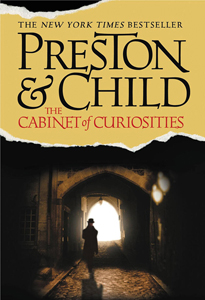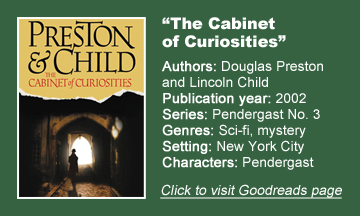Douglas Preston and Lincoln Child hit a turning point with their third Pendergast novel, “The Cabinet of Curiosities” (2002), their only book other than “Relic” to crack NPR’s list of the 100 best thrillers. This is where they embrace the FBI special agent – and other characters for that matter – as a character, not merely an entertaining personality who can make items appear from his coat like magic.
They also effectively push the science fiction another notch, giving us a lot of scientific details but never losing sight of the incredibleness of a formula to extend the human lifespan.
Pendergast’s New Orleans past
Pendergast started off as a New Orleans-bred Southern gentlemen, but that made it difficult for P&C to link him up with another of their great “characters,” New York City. That conundrum is solved in “Cabinet” – with mild clunkiness but ultimately in satisfying fashion.
Pendergast’s relative Enoch Leng was a scientist in NYC overlapping the 19th and 20th centuries. “Cabinet” is a gripping historical mystery wherein Pendergast – along with Nora Kelly (coming over from “Thunderhead”) and other allies — digs through the New York museum archives to unearth Leng’s discoveries.
“Cabinet” always has a nice chill to it because it explores Leng’s experiments on human subjects, who are killed in the process of the removal of the cauda equina at the base of their spine. (Along with the importance of the hypothalamus in “Relic,” P&C have a thing about body parts being the key to scientific leaps.)
This historical mystery gains urgency when a copycat killer – dubbed the Surgeon — seems to be on the loose, and a further chill when it seems Leng might still be alive and continuing his science.
It all leads to the Riverside Drive mansion, which we are familiar with from subsequent Pendergast books. I had forgotten, though, how rundown this neighborhood along the Hudson River is, with many houses being sealed up with tin, having reverted to the city’s possession due to unpaid property taxes.
Exploring the Riverside Drive mansion
The inside of the house is another matter, as seen through the experiences of nosy reporter Smithback and others. I am a sucker for any old house with endless underground rooms and passages, and 891 Riverside Drive takes the cake.
The ultimate answer to Leng’s goals is a little convoluted a weird, but also fascinating: He was looking for a way to wipe out humanity. In an epilog that’s even better than the slightly overlong climax in the mansion, the special agent surmises that Leng stopped his research when he realized humanity would wipe out itself.
The mystery kicks off with the discovery of Mary Greene’s bones at a construction project, and I thought maybe the bizarrely unaged 19th century youth Constance Greene would be introduced here. She is, but only barely, as Pendergast encounters her while dream-walking into the past.
Later, he dream-walks through a New Orleans mansion of his youth, of which the Riverside mansion’s corridors are an exact replica. This is what I mean by the clunkiness, and it’s perhaps a sign that P&C didn’t plan to connect Pendergast to NYC when they invented him.

Digging into the Archives
I had somewhat thought of “Cabinet” as a third installment of a Museum trilogy, following the two “Relic” books. (It has nothing to do with the “Relic” plot threads, so I understand why it’s not grouped with those.) Nora is pursued by the killer through the Archives, and poor archivist Puck is skewered on triceratops horns in a segment I recalled from my first read – incidents that call to mind Margo’s adventures in “Relic.”
We already knew from “Relic” that the museum displays less than 1 percent of its collection, and here we learn that even its undisplayed items have a percentage of which are poorly catalogued. I love the idea that only Puck’s institutional knowledge can help you track down old items, and that he refuses to use tech more modern than a typewriter. Around this time, I was hired by my first professional job by an editor who wrote letters on a typewriter, so this detail made me smile.
Further separating this Museum adventure from the “Relics” is the use of Nora and Sergeant O’Shaughnessy rather than Margo and D’Agosta, both of whom have moved out of the city at this point. I’d be curious to know why P&C made that swap.
My guess is that they wanted to bring relationships more into their writing, and Nora and Smithback had been established as a couple in “Thunderhead.” Also, Margo Green’s name would be distractingly similar to that of Mary and Constance Greene, although of course the authors didn’t have to double up on that name for any apparent reason.
More overtly comedic
As spine-tingling as “Cabinet’s” mystery is, the authors also go more overt with comedy via police Captain Custer, who thinks he has brilliantly deduced that the Surgeon is a Museum official, setting up a huge press conference to announce the arrest.
P&C (and Pendergast) have shown bemused disdain for petty bureaucrats since “Relic,” but this is the first time they make an all-out farce out of it. Custer’s tale is an amusing reprieve from the tension of Pendergast’s pursuit of the real killer, and a nice illustration of the sometimes fine line between good cop work and shoddy cop work. It’s also a playful jab at old-school, conveniently solved mysteries, where the killer’s outfit is in his closet.
This novel is so rich and detailed that, sure, over the course of 629 pages I can find some nitpicks. But it’s ultimately another example of P&C selling me on weird science with those very details, and it brings Pendergast’s heritage more fully into NYC, thus closing the gap between their best character and their favorite setting.
Throw in the faintest hints of Constance’s story starting here, plus the introduction of oddball library archivist Wren and the naming of Pendergast’s driver (Proctor), and this is the point at which P&C know they’ll spend many more novels with the special agent. “Cabinet” is an essential Pendergast read, and I agree with NPR that it’s also one of the best.


